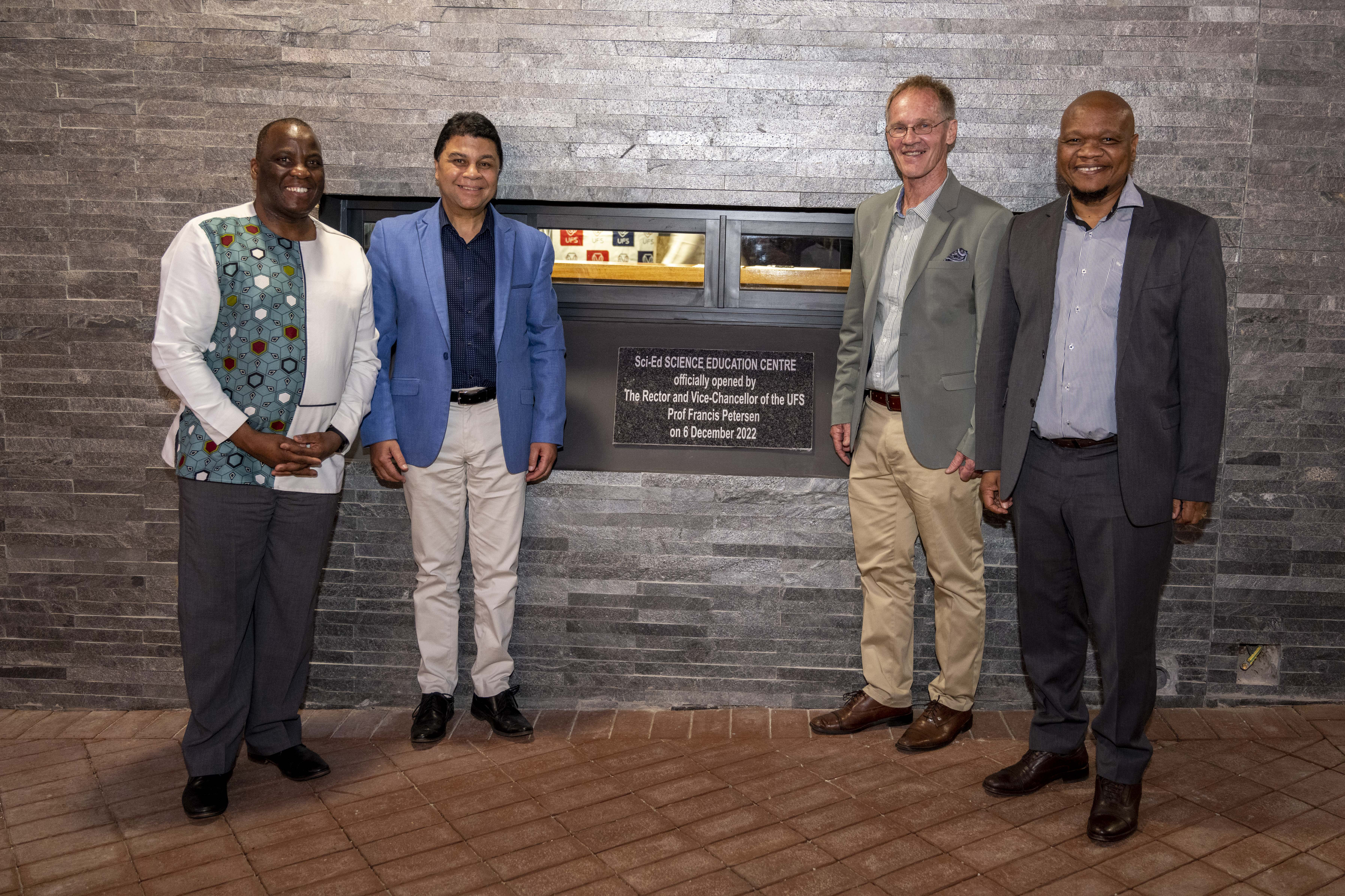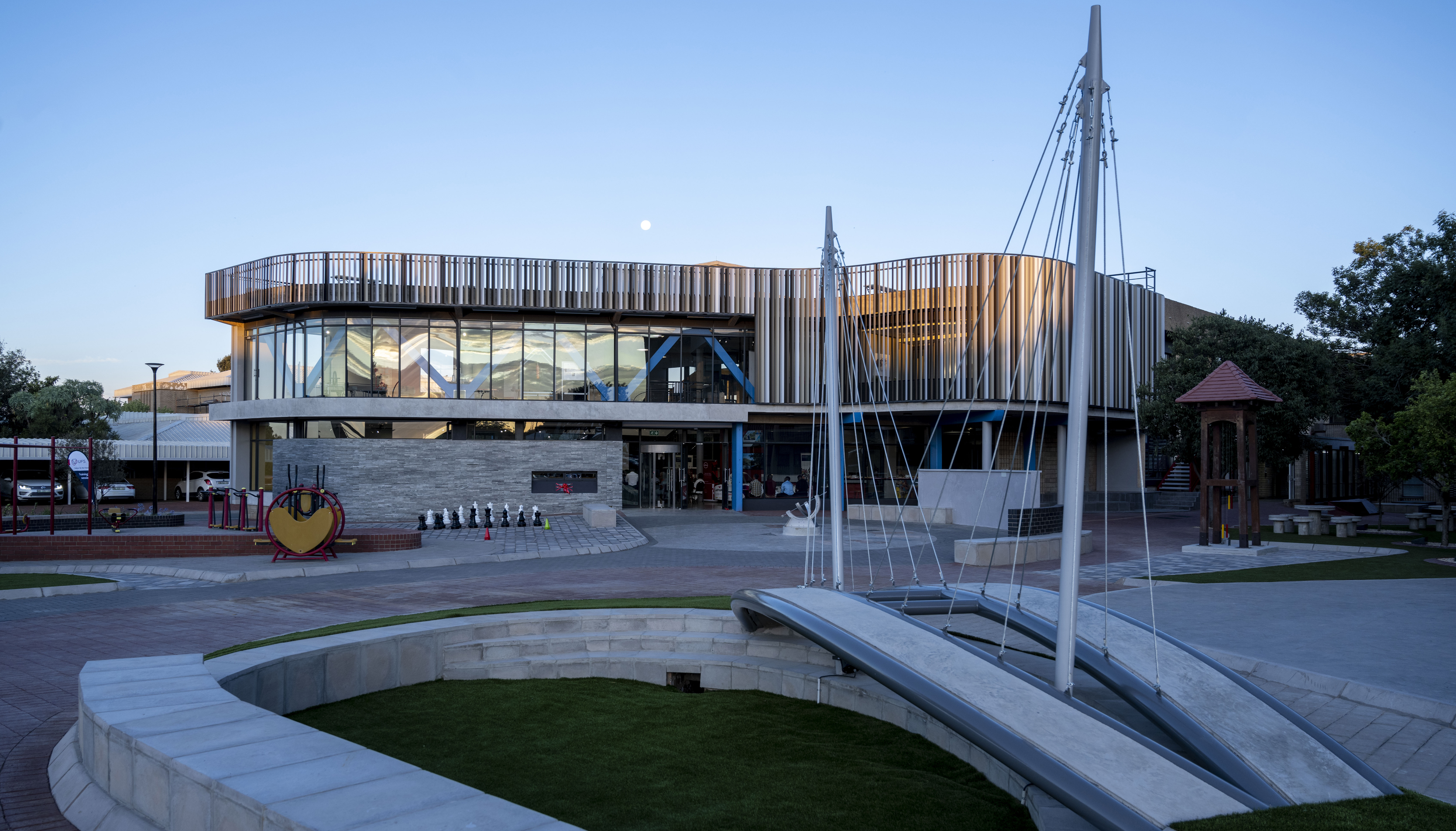08 December 2022
|
Story Leonie Bolleurs
|
Photo Francois van Vuuren
 At the opening of the Science Education Centre on the Bloemfontein Campus, were, from the left: Prof Loyisa Jita, Prof Francis Petersen, Dr Cobus van Breda, and the Honourable Dr Tate Makgoe.
At the opening of the Science Education Centre on the Bloemfontein Campus, were, from the left: Prof Loyisa Jita, Prof Francis Petersen, Dr Cobus van Breda, and the Honourable Dr Tate Makgoe.
“Music is liquid architecture; architecture is frozen music.” – Johann Wolfgang von Goethe.
These were the words used by Marius Coetzee of the Odeion School of Music when he introduced a colleague from the same department, Prof Anmari van der Westhuizen, before she performed a cello solo (GYÖRGY LIGETI mov1) during the opening of the Science Education Centre (Sci-Ed) on the Bloemfontein Campus of the University of the Free State (UFS).
“A worthy piece of music to celebrate a signature building,” Coetzee stated.
The building accommodates the only science education centre in central South Africa, with its mission the advancement of innovative and effective mathematics and science teaching and learning, which is beneficial to student teachers, in-service teachers, learners, parents, and the public at large.
During the opening of the event, the Rector and Vice-Chancellor of the UFS,
Prof Francis Petersen, said universities are about interactive spaces such as the Science Education Centre. He believes it is in spaces such as these where innovations and initiatives are created to tackle science (and the world) of the future.
“We must seek more of these spaces at the UFS. We must ensure that graduates from our university have a solid discipline – that they have their basis right – to prepare them to interact and engage in a multidisciplinary fashion, because that is what the world outside requires."
Speaking about the role of universities in society, Prof Petersen said the purpose of a university is to engage with society. “If we can’t show the public the value of what we have here, the public will ask what the value of universities is. Why do universities exist in the first place? Our role is always to look at things that we do best: our intellectual ability to understand how things work; us challenging specific things and infusing that into society. It is for this reason that we have public lectures, science centres, and other platforms, allowing society to engage with us.”
“Universities are places that evolve continuously, and this centre is an excellent example.”
Referring to the UFS’ twelve-year strategic plan, Vision 130, he said besides visibility, the university will also focus on impact. “We can only show our impact through our graduates, the knowledge that we generate, the research that we conduct, and engaging with society. This centre is all about that.”
The Honourable Dr Tate Makgoe, the MEC for Basic Education in the Free State, shared the sentiment that the impact of universities must be felt by the community. “I am inspired to know that this facility is open to the public. Government will be the main beneficiary of this science centre and we will use it profitably. Among others, I will send our Foundation Phase teachers here,” he stated.

The UFS officially opened the only Science Education Centre (Sci-Ed) in central South Africa on its Bloemfontein Campus. (Photo: Francois van Vuuren.)
An aesthetic and educational added value
Dr Cobus van Breda, Manager of Sci-Ed and Programme Director of the Science-for-the-Future, an initiative hosted by the
UFS Faculty of Education to address the challenge of mathematics and science teaching and learning in South Africa, said that the project had 289 884 participants between 2009 and 2022.
He explained that this project implements mathematics and science teachers’ professional development and outreach programmes across the country.
“In order to extend its impact, it was decided to establish a Science Education Centre to not only enhance its teaching and learning programmes to student educators and in-service teachers, but also to provide a platform to include science communication and engagement with the public. Sci-Ed will be open to the public, and through outreach programmes as well as formal and non-formal visits to the centre, the community can make use of the benefits of the centre,” says Dr Van Breda.
He sees the promotion of parental and family involvement in children’s learning as a priority for Sci-Ed. “Programmes and events aimed at empowering parents and guardians to support their children will also be presented,” said Dr Van Breda.
The Science Education Centre’s main objective, he says, is to create a STEAM+ (Science, Technology, Engineering, Art, Mathematics, and related areas) environment in the South African context, where innovative and 21st century science education (Grade R to Grade 12) can thrive. “The intent of Sci-Ed is to expose, inspire, and empower users while engaging in STEAM experiences and interactive exhibits,” he added.
Merging the old with the new
Dr Van Breda – the passion, drive, and dedication behind Sci-Ed – believes that teaching philosophy and facilities must complement each other. This resulted in the construction of the science centre, a realisation of a dream that started in 2005.
The centre was built in three stages. Phase one of the development involved the construction of the building. An outdoor park area was created during phase two, and interactive exhibits, programmes, and events were planned, developed, and enhanced during phase three to serve the purpose of the facility. “The last part will continue for about six more months, as we want to develop authentic exhibitions that support the university’s teaching and learning philosophy,” said Dr Van Breda.
The Sci-Ed Building, designed to accommodate all the crucial elements of a modern science education centre, is an extension of the existing Winkie Direko Building. Dr Van Breda explained that the architect designed the new building to seamlessly merge with the Winkie Direko Building, which dates from an earlier era. “A conscious decision was made to use some cladding from the old building where it merges into the new facility. This architectural feature can also be seen as a metaphor for building a bright new future on sound foundations,” he said.
With its interactive exhibits, Sci-Ed will make it possible for the numbers of students, student educators, in-service educators, learners, parents, other interest groups and the public who will enter its doors, to engage in a hands-on manner with activities, and as such experience a science principle. “Using interactive exhibits, we also hope to evoke questions that will stimulate discussion and enhance learning, especially coincidental learning,” said Dr Van Breda.
He added that Sci-Ed will also serve as a social space on campus, where all students can interact within a fun and exciting popular science environment.
Prof Loyiso Jita, Dean of the Faculty of Education, described the building as a dream come true. It is not just about the building, it is also about creating an intellectual space, both indoors and outdoors, to encourage students, staff, and the community to interact with science.
_web-content-new.jpg?Status=Master&sfvrsn=44d15320_1)